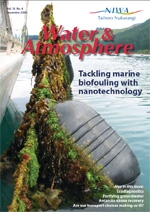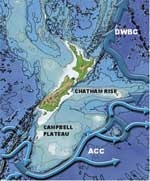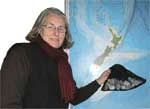In her year as a New Zealand Science, Mathematics and Technology Teacher Fellow, Jenny Pollock has focused her attention on the ACC.
PDF of this article (187 KB)



New Zealanders may sometimes forget that we dwell in the middle of vast, restless oceans through which large currents that control the world’s climate flow. These currents are like huge rivers within the ocean, responsible for transporting ocean water and with it heat, salts, dissolvedgases, nutrients, and marine life. Surface currents are driven by wind, and deep currents are driven by gradients in density, a function of salinity and temperature. The Earth’s spin and the topography of the ocean floor strongly affect the direction in which currents flow.
Antarctic Circumpolar Current
The huge, cold Antarctic Circumpolar Current (ACC) flows south of New Zealand, completely encircling the globe. Formed by persistently strong westerly winds which transfer large amounts of momentum to the current, the ACC flows eastward around Antarctica, connecting the Atlantic, Pacific, and Indian oceans. It transports 110–150 million cubic metres of water per second; by comparison, all the water flowing out of all the world’s rivers is about a million cubic metres persecond.
Unlike other major currents, the ACC reaches from the surface to the bottom of the ocean. In places it is as deep as 4000 metres and as wide as 2000 kilometres. Mostly the current flows unimpeded, but underwater topography, such as the Drake Passage between South America and Antarctica and the ridges and plateaus south of New Zealand, act as barriers that constrict, deflect, and alter the flow.
Measuring the ACC
Because the ACC is linked to the three major oceans and is important in global ocean circulation and climate, it is essential that scientists understand and monitor its flow and detect any changes. Research on ocean circulation in the Southern Ocean is difficult because the ocean is stormy, the weather is generally bad, and the area to cover is vast. Oceanographers must choose their methods and sites for gathering data very carefully.
It happens that New Zealand is well placed for studying the ACC. The Macquarie Ridge, an underwater mountain range that rises 2000–3000 m from the seabed and stretches south of New Zealand for 1400 km, is one of the few places where the ACC deviates from its relentless circling of the globe.
Currents driven by density gradients, such as the ACC, are known as thermohaline circulation (thermo = temperature, haline = salinity), and the ACC has a profound influence on the world’s climate because it is part of the global thermohalinecirculation. Cold, dense water sinking around Antarctica and in the north Atlantic drives this circulation. These waters, already cooled by the atmosphere, become even denser as a result of sea ice formation. When sea ice forms the salt from the sea water is expelled as brine, increasing the density of the water below and allowing it to sink into the deep ocean. From there it flows northwards, joining with the ACC. Branching off the ACC, Deep Western Boundary Currents (DWBC) carry this deep water into the Indian, Atlantic, and Pacific oceans, travelling 2–5 km below the surface. The DWBC flows eastwards around the Campbell Plateau, past the Chatham Rise along the Kermadec trench and into the north Pacific.
Data from the Macquarie Ridge
In 2007, NIWA scientists on board RV Tangaroa dropped nine instrumented moorings in two gaps in the Macquarie Ridge through which the ACC squeezes. The moorings were over 3500 m long and were anchored to the bottom of the ocean by old railway wheels. Current meters on the mooring lines measured and recorded the speed, direction, and volume of the current at fixed positions under the surface to create a picture of how the ACC flows through the ridge. The instruments collected data continuously for a year before the moorings were retrieved in April 2008. The data showed that the speed of the current passing through the Macquarie Ridge is about 4 km per hour – the speed an adult would walk quickly, and very fast for an ocean current. Other instruments on the moorings measured temperature and salinity.
The data from the Macquarie Ridge will be compared with data from other moorings, such as those placed in the Drake Passage, to form an idea of how much water is flowing out into the Pacific and how much is staying to circulate around the Southern Ocean. Scientists are also looking for climate-related changes in ocean circulation by comparing the salinity, temperature, and density data with similar data collected since the 1960s. All these data will inform climate-change research.
Such changes could have an as yet unknown effect on global climate as the thermohaline circulation is finely balanced. The energy and extent of the deep and shallow flows depend on a balance between evaporation and freshwater supply, temperature distribution through the ocean, and wind patterns. Any or all of these factors may change as global warming continues.
Global impact
- The Antarctic Circumpolar Current encircles Antarctica, linking the Atlantic, Pacific, and Indian oceans.
- One way it affects global climate is through transporting cold polar water toward the Equator.
- New measurements of the current as it passes through the Macquarie Ridge will help detect changes that may be caused by global warming.
From the classroom to the open seas

This year I’m lucky enough to have had a New Zealand Science, Mathematics and Technology Teacher Fellowship, but in my other life I teach Science at Nelson College for Girls. ‘Science’ covers many science disciplines in a general way and is the only course that teaches anyEarth Science. I realised that I had a solid general knowledge of New Zealand’s interesting geology but that I knew very little about the vast oceans surrounding our country. So this year I decided to study ocean circulation, with NIWA marine physicist Mike Williams as my supervisor.
My home is in Nelson so I have spent the year going between the NIWA campuses in Nelson and Wellington where Mike is based. The year has been varied and interesting and has included attending lectures given by Mike and Lionel Carter, formerly at NIWA and now a professor at Victoria University, and developing experiments and resources on seawater density that can be used in the classroom. One of the highlights was a three-week voyage on NIWA’s research vessel, Tangaroa, where I was able to observe and participate in the multidisciplinary programme organised by Julie Hall to investigate the current state of the marine food web of the Chatham Rise.
I also updated the CenSeam website with daily logs from the Tangaroa voyage to Macquarie Ridge, liaising with Mireille Consalvey and learning valuable web skills in the process. An interesting aspect of this was linking the voyage with class 9St from my school; they asked the scientists about everything from “Has anyone ever fallen overboard?” to “Have you ever found a dinosaur fish?” All the students were fascinated by Mike and Mireille’s before-and-after talks and by a graphic demonstration of water pressure: before the voyage they gave the scientists decorated polystyrene cups that returned much smaller after being deployed to 1000 metres depth.
Studying ocean circulation has taught me about the influence of the major ocean currents on global climate and climate change. As if that’s not worry enough, Kim Currie has introduced me to the rather scary probability of acidification of the oceans and the effect that this will have on marine ecosystems and the sequestering of carbon.
It’s been a fascinating year. My thanks go to all the people mentioned in this profile and to the Royal Society of New Zealand for the opportunity to be an NZSMT Teacher Fellow.
Two other NZSMT Teacher Fellows are profiled here. For further information on the programme, contact: Dr Julie Hall, 0-4-386 0322, [email protected]
The author thanks Dr Mike Williams, Dr Mireille Consalvey (both NIWA), and Dr Lionel Carter (Victoria University of Wellington) for their contribution to this article.
Teachers’ resource for NCEA Achievement Standards or Unit Standards: Biology Level 3 US6319, US90714 Environmental Sustainability Level 2 AS90811, AS90814 Geography Level 3 US5098, US5099, AS90701 Science Level 3 US6355, US21613, AS90728
